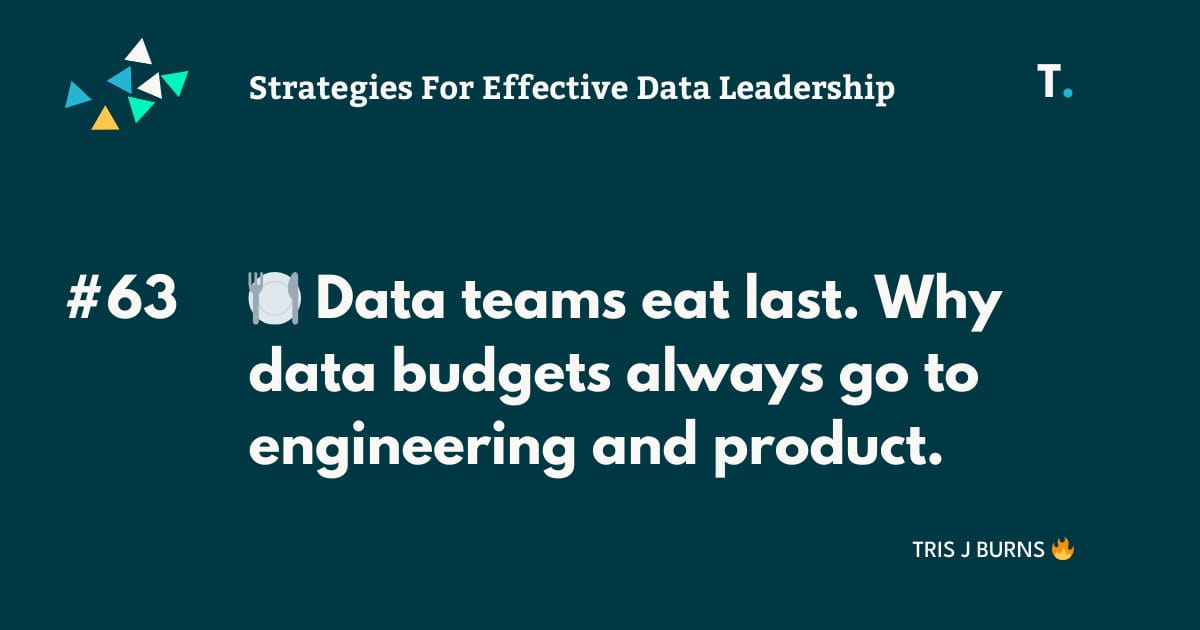
You found global talent. Deel’s here to help you onboard them
Deel’s simplified a whole planet’s worth of information. It’s time you got your hands on our international compliance handbook where you’ll learn about:
Attracting global talent
Labor laws to consider when hiring
Processing international payroll on time
Staying compliant with employment & tax laws abroad
With 150+ countries right at your fingertips, growing your team with Deel is easier than ever.
READ TIME: [5] MINUTES
Why Data Teams Struggle to Get Budget (and How to Fix It)
Year after year during annual planning, I’d submit my request to grow my data team to accommodate the increasing data demands of the business. And year after year, I’d see my initial allocation of 4 new headcount positions cut to 3, then 2, then 1 and ultimately either ZERO.
Or perhaps they’d let me could hire a contractor for ~6 months (maybe).
Where did my budget end up going? Why… to engineering and product of course!!

Most data leaders know the frustration…budget is constantly re-allocated to product and engineering, while analytics teams struggle to get the investment they need.
Why is this?
Because product and engineering are seen as building tangible value with client facing features and services you can touch and feel. Meanwhile, data teams are too often viewed as information radiators, simply reporting on what happened rather than driving what should happen next.
And when this is the case, it makes perfect sense not to grow data teams. Why invest in something that is a cost while not investing in something that will build revenue generating assets?
Unless data leaders and their teams are able to shift the perception AND become revenue positive teams, we can expect our data budgets to continue to shrink and be re-allocated elsewhere.
Poll Time 👇🏻
What’s the biggest reason your data team struggles to get budget?
(check below to see the results of last week’s poll)
What is the impact of this?
❌ Data is sidelined in key decisions
If you're only reflecting on the past, you won’t be invited to shape the future.
❌ Budget keeps going elsewhere
Leadership invests in areas they see as directly driving revenue and growth. If you aren’t positioned as a creator of commercial impact, you’re not a priority
❌ Analytics teams become order-takers
Without a strategic role, data functions get trapped in a cycle of reactive work, answering endless stakeholder questions but never influencing the bigger picture.
❌ Career progression stalls
The most impactful leaders are those who direct the business, not just analyse it. If you want a seat at the table, you need to prove your value beyond reporting.
The good news? You can shift the perception of your data team and unlock bigger budgets.
Here’s how: 👇🏻

The Bad Ass Book Shelf is not just a book club. It is an active community filled to the brim with senior data folks.
Together, via our vibrant Discord Channel, we share our insights on the books we’re reading each month and network like crazy.
Not only does being a member get you access to our community, it also enables you to grow personally and professionally through some of the world’s most valuable business, leadership and personal development books.
Why not grow your network and become a Bad Ass at the same time.
Best yet - it’s totally free to join!
👷🏽♂️ Can we fix it? Yes, we can!
Step 1: Move from downstream to upstream
Most data teams focus on measuring success after a product or service is launched. Flip the script. Use data to guide what should be built in the first place. Show leadership how data can identify new opportunities, validate product-market fit, and shape investment decisions before development begins.
Step 2: Deliver clear, commercial recommendations
Insights are not enough. If all you’re doing is presenting dashboards and reports, you’ll be seen as an information radiator, not a value creator. Instead, every data output should include clear recommendations tied to commercial outcomes. What should the business do with this information? What impact will it have on revenue, cost, or efficiency?
Step 3: Speak the language of the business
Executives don’t care about your model accuracy or data pipelines, they care about growth, risk reduction, and efficiency. Frame your insights in those terms. For example: instead of saying, "Our analysis shows customer churn is up 12%," say, "By investing in proactive retention campaigns, we can recover £2M in lost revenue."
Step 4: Embed data in decision-making, not just reporting
If your team only delivers reports after the fact, decision-makers will continue to rely on gut feel when planning future investments. Instead, make data a required input before big bets are made. That means partnering with finance, strategy, and product teams early in the decision cycle, not just when results need to be measured.
Step 5: Prove ROI on data initiatives
Every team getting a big budget increase has one thing in common: they can justify the return on investment. If you want more funding, start quantifying the impact of past data-driven decisions. Show how insights have increased revenue, reduced costs, or unlocked efficiencies. Build a track record of commercial wins.
The shift from “information radiator” to “decision driver” is the key to getting the investment your team deserves. Change how you position your value, and you’ll change how leadership sees your team.
And remember to channel your Bob the Builder!
🤯 Massive S*le on Now!
My Self Paced Coaching products are currently 75% OFF.
DIY Coaching - This self-paced email series and accompanying exercises provides actionable tools to help data professionals navigate career transitions, set goals, and achieve success.
Data Leadership Frameworks - This self paced email series contains 10 value-packed frameworks, each tackling and tearing down major data leadership challenges.
To take advantage of 75% OFF use promo code: DIY75

⚡️ Previous poll results
Last week we were talking about getting promotions and pay rises. I dropped you a practical guide on how to position and negotiate for a promotion.
I also asked you what the biggest obstacle preventing you from getting a promotion was. 100% of you answer in the exact same way.
There is no clear promotion pathway in your company.
My question back to you is…. why do you tolerate this and continue to work there!?


Tristan Burns
💡 Helpful resources for data professionals:
The Data Leadership Frameworks: This email series containing 10 data leadership frameworks, will equip you with the necessary skills and knowledge to maximise your effectiveness and become the influential and powerful data leader you know you can be.
DIY Coaching Program: Through a series of 9 self-guided exercises, you’ll clarify your goals, overcome obstacles, and create a plan for your next career move - all at your own pace.
⚡️Three more ways I can help you:
Private Coaching for Data Leaders: I work with data professionals looking to grow into influential and unstoppable data leaders to help them navigate and overcome the challenges of being a data leader.
Group coaching for Data Teams: Great data teams can make or break businesses. Through my facilitated 6-week group coaching program, together we get to the heart of what is holding teams back and set a course for data-driven success.
Google Analytics, Tagging and Looker Support: Helping teams to set up or optimising their data eco system, generate actionable insights and gain more in-depth knowledge through training.
What did you think of this email?
If you enjoyed this newsletter, why not forward it to a friend.
Did someone forward you this email? You can subscribe to Strategies for Effective Data Leaders here!


